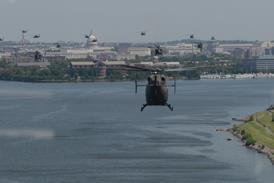Any visitor to Shanghai is easily charmed by its bewildering mix of old and new. Neon lights bejewel 1920s façades, and rickshaws vie for space with resplendent new Volkswagens in the city's ever-widening roads.
It's fitting that as the main carrier serving China's eastern gateway, China Eastern Airlines should also be a curious combination of old and new influences.
While the vestiges of state influence may still hang heavy over China Eastern, the airline remains the leader of China's pack in deregulation terms and is embracing western business practices.
China Eastern has quickly adopted the two prevalent trends that are about to dominate the next decade of Chinese aviation - partial privatisation and consolidation. Not only was China Eastern the first Chinese airline to list abroad, successfully issuing shares in New York and Hong Kong in February 1997, it is also the first Chinese major to acquire one of the country's smaller players, having begun the process of sweeping China General Aviation Corporation under its wing.
Completing these two important steps will dominate China Eastern's strategy in the immediate future. Firstly, the airline will 'complete our overseas and domestic listings to enhance the company's capacity and increase its equity funding', says Zhou Ming, China Eastern's deputy finance director. Then it will 'merge with other airlines in China as happened with China General Aviation', he adds.
China Eastern was clearly in the right place at the right time. The carrier boasts a prime location at Shanghai's Hongqiao airport, and is poised to muscle in on Shanghai's emergence as China's main commercial, financial and industrial centre. And the recent election of China Eastern's chairman, Wang Li'an, as vice minister of the CAAC could pull some useful strings for the airline.
As well as capitalising on its good connections and location, China Eastern has plenty of work elsewhere. The airline needs to build up its network, quickly ally with reputable overseas partners and sharpen up its emerging marketing skills.
China Eastern's balanced network of domestic, international and regional services gives it a firm foundation from which to grow. Its diverse revenue base is backed by a strong balance sheet and steadily improving operating margin.
And China Eastern is ahead of the other Chinese airlines in getting its image into shape. Safe, punctual, comfortable and on-time are the words most associated with China Eastern in the domestic market nowadays. In 1996 the CAA Cranked CEA the top Chinese airline in terms of management, quality of service, flight punctuality and operating performance in 1996. Now the airline just needs to advertise the fact to the rest of the world.
As well as a better image, the airline desperately needs allies overseas. However encouraging signs are emerging from talks with potential US and European partners.
China Eastern's first priority is to complete its listings. The airline has already covered a lot of ground by raising an estimated RMB2.1 billion (US$250 million) from its initial public offering on the world's markets in February 1997. The issue in Hong Kong was oversubscribed 23 times, generating some US$56 million, while some US$113 million was raised in the US.
Encouraged by its auspicious debut on the international stage, China Eastern is planning to sell additional shares on the domestic Shanghai exchange at the end of 1997. The airline plans to list 300 million 'A' shares to raise some US$100 million to 'further enhance the company's capacity and its high debt: equity ratio', says China Eastern's deputy chief accountant, Xia Yi. Long-term liabilities stood at RMB14.6 billion (US$1.8 billion) last December.
A domestic listing will allow China Eastern to sell more shares without breaching China's 35 per cent maximum foreign ownership limit. The airline was nudging close to this limit with its foreign listing - the total issue of 1.4 billion shares represented 32 per cent of its equity.
Funds from the listings will be used to fund aircraft purchases, spares, a new flight simulator and airport construction projects. The company has directed some US$133 million into funding construction projects at Shanghai's new Pudong airport, and US$210 million into prepayment of new aircraft purchases and aircraft loan repayments.
At presstime the airline had five Airbus A340s on order - though it had said it would not take delivery of three of these (see Newsline) - and nine Boeing/McDonnell Douglas MD-90s.
Airbus dominates China Eastern's 64-aircraft fleet. Its existing three A340s, purchased in 1996, are used on routes to Europe and Australia, while its 10 A300-600s cover regional services to southeast Asia. The airline may add Boeing aircraft after its five-year restructuring plan expires in 2000. 'We're merging with China General Airlines which already has Boeings in its fleet,' points out Zhou.
The airline's merger with China General should be complete in late 1998. Under Chinese regulations, China Eastern cannot merge with another company until after the 'A' shares listing.
China General is set to be just the first in a long line of planned acquisitions as China Eastern falls into line with the CAAC's rationalisation plans. These aim to curb a decade of explosive growth and reduce China's current 30 airlines down to 10 within the next five years. China Eastern is heading the queue to gobble up the smaller players and has set up a management committee to study the acquisition of fellow Chinese airlines.
Chin Y Lim, an analyst at Morgan Stanley, Singapore, says China Eastern is ideally placed to capitalise on the consolidation trend. 'CEA's relative financial strength and operational efficiency increase the likelihood of the airline gaining CAAC's approval for acquisitions.'
The airline's acquisition of domestic carriers falls in with its belief that growth in both capacity and monetary terms lies in the domestic market. 'Domestic yield at 8 RMB per RTK is greater than international yield at 5,' says Xia. Domestic sales amounted to RMB2.5 billion (US$306 million), or 43 per cent of passenger revenues, in 1996.
China Eastern is also well positioned to take advantage of China's predicted 10 per cent annual traffic growth. Shanghai is widely recognised as China's booming commercial nucleus and, to cater for the increased number of passengers set to flock to Shanghai, the city is about to become the first in China with two civil airports.
Construction of Shanghai's US$1.7 billion Pudong International airport is due to be completed by the end of 1999 with its opening planned by 2000. Pudong will mainly handle international flights, with most domestic services remaining at Hongqiao, though each will serve as the other's standby airport, says Yu Wuyan, deputy commander-in-chief, Shanghai airport.
In addition to its Shanghai-based operations, China Eastern's four provincial hubs in Anhui, Jiangsu, Jiangxi and Shandong are also well located. Jiangsu and Shandong are among the most economically developed provinces in China.
While China Eastern eyes new routes and acquisitions in the domestic market, internationally the airline plans to enhance capacity on existing routes and introduce codesharing and alliances, says Zhou.
Talks are underway with Air France, Lufthansa and British Airways with a view to signing a codeshare and forming an alliance with a longed-for European partner. Meanwhile, China Eastern is currently awaiting US and Chinese government approval for its planned codeshare with American Airlines. This will operate from Beijing, via Shanghai, to Los Angeles with an extension to New York or Chicago, says Xia. The airline is also negotiating a special prorate agreement with Ansett Australia and Qantas.
International services accounted for 29 per cent of passenger revenues in 1996 and destinations include Sydney, Seoul, Tokyo, Osaka, Fukuoka, Nagasaki, Bangkok and Singapore, as well as Los Angeles, Seattle and Chicago in the US and Brussels, Munich and Madrid in Europe. Membership agreements were recently signed with several major reservations systems, including Abacus, Sabre and Galileo.
As China Eastern firms up its international strategy, competitive threats are snapping at its heels. In addition to the overseas majors' sharpening interest in Shanghai, China Eastern now faces home-spun competition on international routes from local rival Shanghai Airlines. After years of lobbying, in September Shanghai Airlines won approval from the CAAC to launch overseas services.
Shanghai Airlines operates more than 70 domestic routes, using a fleet of eight B757s and one B767-300, with four B767s on order and the possibility of several more B737s in 1998.
But China Eastern dismisses any notion of Shanghai Airlines being a competitive threat. 'They're a smaller airline than us so they haven't got the capacity to compete,' says Xia.
Indeed, China Eastern is confident it can stave off competition. 'Firstly, we've emphasised "safety first" and quality of service, with consistent safety standards and safety-related training programmes,' says Zhou. 'Secondly, we've scheduled routes for our passengers' convenience. Thirdly, we've reduced our costs below revenue levels by enhancing capacity and aircraft maintenance and reducing administration costs by improving management efficiency and employee productivity.'
While the airline nears codeshare agreements for scheduled services, it is putting the finishing touches to plans to cooperate in the cargo sector.
'Cargo is another focus in the company's future development and we plan to cooperate with another domestic company to create a cargo airline. This will be the first time this has been done in the PRC, so the rights for overseas routes will be very sensitive,' says Zhou. The company's cargo and mail business turned in revenues of RMB1.1 billion (US$134 million) in 1996, representing some 15 per cent of the airline's operating revenues for the year. Some 70 per cent of cargo and mail revenues are international, with one MD-11F operating five flights per week to Japan and one flight per week each to Europe and the US.
As Shanghai bursts onto the international scene as China's fastest-growing centre of commerce, China Eastern is set to piggyback on its success story. But in turn, the airline's fortunes and ability to attract partners are largely tied to the continuation of Shanghai's economic miracle.
Source: Airline Business























